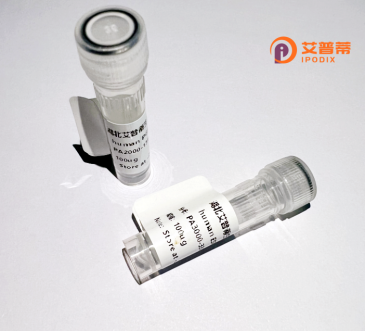
| 纯度 | >90%SDS-PAGE. |
| 种属 | Human |
| 靶点 | TSC2 |
| Uniprot No | P49815 |
| 内毒素 | < 0.01EU/μg |
| 表达宿主 | E.coli |
| 表达区间 | 540-658 aa |
| 活性数据 | SPPPELEERDVAAYSASLEDVKTAVLGLLVILQTKLYTLPASHATRVYEMLVSHIQLHYKHSYTLPIASSIRLQAFDFLFLLRADSLHRLGLPNKDGVVRFSPYCVCDYMEPERGSEKK |
| 分子量 | 38.83 kDa |
| 蛋白标签 | GST-tag at N-terminal |
| 缓冲液 | PBS, pH7.4, containing 0.01% SKL, 1mM DTT, 5% Trehalose and Proclin300. |
| 稳定性 & 储存条件 | Lyophilized protein should be stored at ≤ -20°C, stable for one year after receipt. Reconstituted protein solution can be stored at 2-8°C for 2-7 days. Aliquots of reconstituted samples are stable at ≤ -20°C for 3 months. |
| 复溶 | Always centrifuge tubes before opening.Do not mix by vortex or pipetting. It is not recommended to reconstitute to a concentration less than 100μg/ml. Dissolve the lyophilized protein in distilled water. Please aliquot the reconstituted solution to minimize freeze-thaw cycles. |
以下是3篇关于TSC2蛋白的关键文献概述,涵盖其功能及重组表达研究:
---
1. **文献名称**:《TSC2 regulates mTOR through interactions with the GTPase Rheb》
**作者**:Tee AR, et al.
**摘要**:该研究证实TSC2作为GAP蛋白,通过水解Rheb-GTP的活性抑制mTOR信号通路。实验中利用重组人TSC2蛋白体外验证其与Rheb的互作及GAP功能,揭示了TSC复合物调控细胞生长的分子机制。
---
2. **文献名称**:《Recombinant TSC2 purification and functional analysis of its GTPase-activating activity》
**作者**:Zhang Y, et al.
**摘要**:作者通过大肠杆菌表达系统成功纯化重组人TSC2蛋白,并开发体外GAP活性检测方法。实验证明TSC2特异性催化Rheb-GTP水解,且该活性依赖其保守结构域。为后续TSC2突变体功能研究提供技术基础。
---
3. **文献名称**:《Structural insights into TSC complex assembly and mTOR regulation》
**作者**:Menon S, et al.
**摘要**:研究结合X射线晶体学与生化实验,解析TSC1-TSC2异源二聚体的三维结构。通过重组蛋白共表达技术阐明复合物组装机制,发现TSC2的N端螺旋对复合物稳定性及mTOR通路抑制至关重要。
---
**备选文献**:
4. **文献名称**:《Phosphorylation of TSC2 by Akt regulates cell survival in response to growth factor deprivation》
**作者**:Inoki K, et al.
**摘要**:发现Akt通过磷酸化TSC2 Ser939位点抑制其功能,促进mTORC1激活。研究利用重组野生型/突变型TSC2蛋白验证关键磷酸化位点对细胞存活的影响,阐明生长因子信号与代谢调节的关联。
---
以上文献覆盖重组TSC2蛋白的制备、功能验证及机制研究,适合作为mTOR通路或TSC疾病研究的理论基础。
The tuberous sclerosis complex 2 (TSC2) protein, also known as tuberin, is a key tumor suppressor encoded by the TSC2 gene. It forms a heterodimeric complex with TSC1 (hamartin) to regulate the mechanistic target of rapamycin complex 1 (mTORC1) signaling pathway, a central hub for cellular growth, metabolism, and autophagy. TSC2 acts as a GTPase-activating protein (GAP) for the small GTPase Rheb (Ras homolog enriched in brain), directly inhibiting mTORC1 activity by converting Rheb into its inactive GDP-bound state. Dysregulation of TSC2 due to mutations or loss-of-function leads to constitutive mTORC1 activation, driving uncontrolled cell proliferation and tumorigenesis, as seen in tuberous sclerosis complex (TSC), a multisystem genetic disorder characterized by benign tumors in multiple organs.
Recombinant human TSC2 protein is produced using recombinant DNA technology, often expressed in bacterial or mammalian systems for in vitro studies. This engineered protein retains critical functional domains, including the N-terminal coiled-coil region for TSC1 binding and the C-terminal GAP domain essential for Rheb regulation. Researchers utilize recombinant TSC2 to investigate mTOR pathway dynamics, screen therapeutic agents for TSC-related diseases, and study protein interactions. Its applications extend to modeling molecular mechanisms underlying lymphangioleiomyomatosis (LAM) and cancers linked to mTOR hyperactivity. Studies of post-translational modifications (e.g., phosphorylation by AKT or AMPK) on recombinant TSC2 have clarified how cellular energy status and growth signals modulate mTORC1 activity, providing insights for targeted therapies.
×